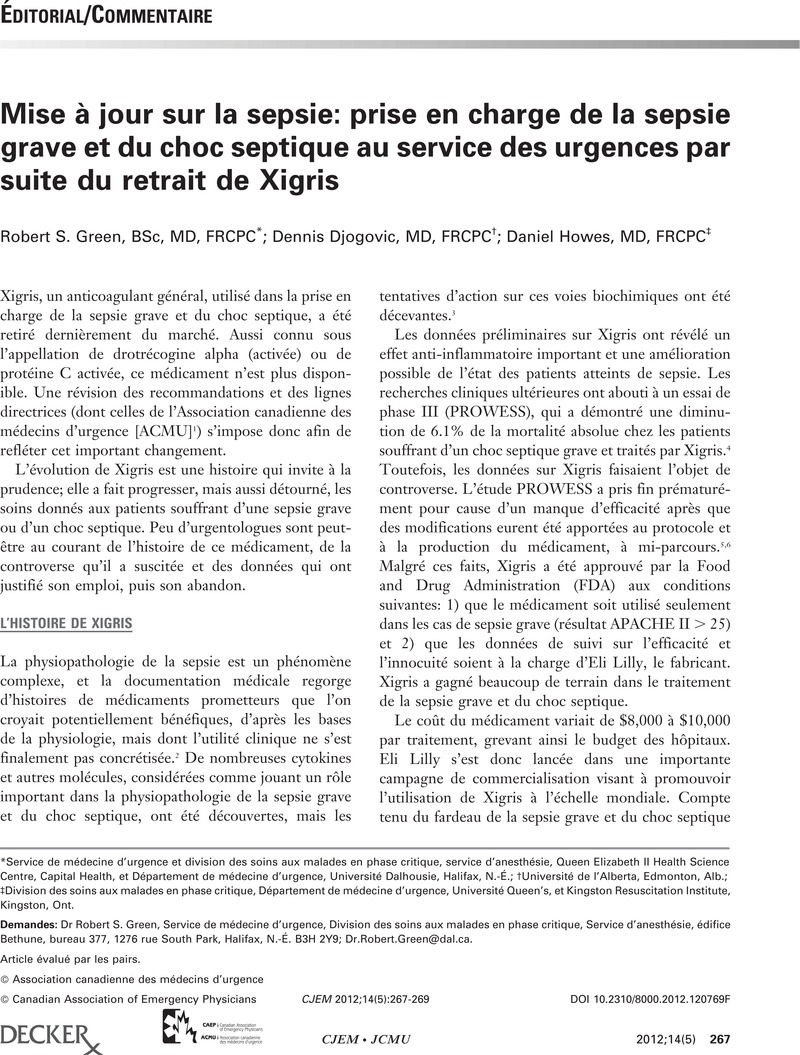No CrossRef data available.
Article contents
Mise à jour sur la sepsie: prise en charge de la sepsie grave et du choc septique au service des urgences par suite du retrait de Xigris
Published online by Cambridge University Press: 11 May 2015
Abstract
An abstract is not available for this content so a preview has been provided. As you have access to this content, a full PDF is available via the ‘Save PDF’ action button.

Keywords
- Type
- Éditorial/Commentaire
- Information
- Copyright
- Copyright © Canadian Association of Emergency Physicians 2012
References
RÉFÉRENCES
1.Green, RS, Djogovic, D, Gray, S, et al. CAEP Critical Care Interest Group. Canadian Association of Emergency Physicians sepsis guidelines: the optimal management of severe sepsis in Canadian emergency departments. CJEM 2008;10:443–59.Google Scholar
3.Zanotti, S, Kumar, A, Kumar, A. Cytokine modulation in sepsis and septic shock. Expert Opin Investig Drugs 2002;11:1061–75, doi:10.1517/13543784.11.8.1061.CrossRefGoogle ScholarPubMed
4.Bernard, GR, Vincent, JL, Laterre, PF, et al. Recombinant Human Protein C Worldwide Evaluation in Severe Sepsis (PROWESS) study group. Efficacy and safety of recombinant human activated protein C for severe sepsis. N Engl J Med 2001;344:699–709.CrossRefGoogle Scholar
5.Warren, HS, Suffredini, AF, Eichacker, PQ, et al. Risks and benefits of activated protein C treatment for severe sepsis. N Engl J Med 2002;347:1027–30.Google Scholar
6.Siegel, JP. Assessing the use of activated protein C in the treatment of severe sepsis. N Engl J Med 2002;347:1030–4.CrossRefGoogle ScholarPubMed
7.Dellinger, RP, Carlet, JM, Masur, H, et al. Surviving Sepsis campaign guidelines for management of severe sepsis and septic shock. Crit Care Med 2004;32:858–73, doi:10.1097/01.CCM.0000117317.18092.E4.CrossRefGoogle ScholarPubMed
8.Eichacker, PQ, Natanson, C, Danner, RL. Surviving sepsis—practice guidelines, marketing campaigns, and Eli Lilly. N Engl J Med 2006;355:1640–2.CrossRefGoogle ScholarPubMed
9.Abraham, E, Laterre, PF, Garg, R, et al. Drotrecogin alfa (activated) for adults with severe sepsis and a low risk of death. N Engl J Med 2005;353:1332–41.Google Scholar
10.Nadel, S, Goldstein, B, Williams, MD, et al. Drotrecogin alfa (activated) in children with severe sepsis: a multicentre phase III randomised controlled trial. Lancet 2007;369:836–43, doi:10.1016/S0140-6736(07)60411-5.CrossRefGoogle ScholarPubMed
11.Finfer, S, Ranieri, VM, Thompson, BT, et al. Design, conduct, analysis and reporting of a multinational placebo-controlled trial of activated protein C for persistent septic shock. Intensive Care Med 2008;34:1935–47, doi:10.1007/s00134-008-1266-6.Google Scholar
12.Krauskopf, L, Pierson, R. UPDATE 4-Lilly pulls sepsis drug Xigris, no benefit found, Reuters.com US Edition. October 25, 2011. Available at: http://www.reuters.com/article/2011/10/25/elililly-idUSN1E79O08320111025.Google Scholar
13.Ferrer, R, Artigas, A, Levy, MM, et al. Improvement in process of care and outcome after a multicenter severe sepsis educational program in Spain. JAMA 2008;299:2294–303, doi:10.1001/jama.299.19.2294.Google Scholar
14.Puskarich, MA, Marchick, MR, Kline, JA, et al. One year mortality of patients treated with an emergency department based early goal directed therapy protocol for severe sepsis and septic shock: a before and after study. Crit Care 2009;13: R167. [Epub 2009 Oct 21], doi:10.1186/cc8138.Google Scholar




